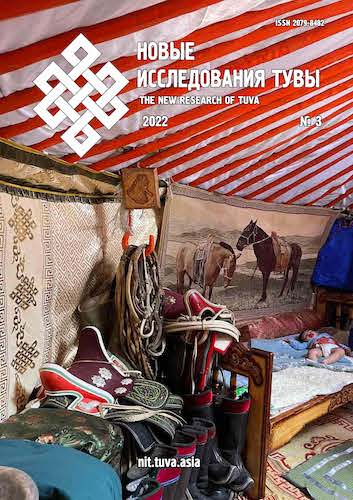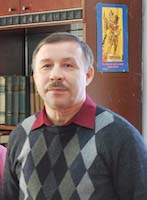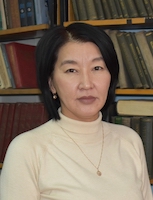The Kamby Lama Ondar Lopsan-Chamzy (1857–1930): The main milestones of historical biography
DOI:
https://doi.org/10.25178/nit.2022.3.9Keywords:
Ondar Lopsan-Chamzy; Uriankhai Krai; Tuva; Russia; China; Mongolia; Buddhist monastery; khuree; protectorate; Pandido Kamby Lama; Civil war; political repressionAbstract
The article is the first attempt to examine the historical biography, political and spiritual activities of one of the famous religious figures of Tuva, the abbot of the Upper Chadan Buddhist Monastery (khuree) Ondar Lopsan-Chamzy (1857–1930). The study responds to the need to refute inaccurate and incorrect beliefs about him. We clarify some facts of his biography that are related to his origin, spiritual education and staying in exile, the place and circumstances of his death. The ideas about his attitude towards the revolutionary changes that were taking place in Russia are concretized. A special attention is paid to his ideological and political position at crucial and landmark moments in the history of Tuva and Russia (1916–1921). The authors consider his active participation and important role in the establishment of the religious institute of the Pandido Kamby Lama in the region. It was the prototype of contemporary institute of the Kamby Lama of Tuva.
The reorganization of the Buddhist Sangha of Tuva was undertaken by the Russian authorities in order to eliminate the submissive and dependent position of Tuvan ministers of the Buddhist cult in relations with religious institutions in Mongolia and Tibet. It implied the unification of all Tuvan monasteries under the leadership of an authoritative Buddhist hierarch. The most suitable candidate for this position, according to the Russian authorities, was Lopsan-Chamzy who considered Russia’s patronage over Tuva as a benefit for his people. He described his vision of Buddhist religious practice in Tuva in a list of moral teachings and requests attached to his petition for placing Tuva under the protectorate of Russia in 1914.
The Kamby Lama’s persistent political orientation to the monarchical Russia in the conditions of socialist modernization in Tuva doomed him to a tragic end.
References
Berdyaev, N. A. (2016) Smysl istorii [The meaning of the history]. St. Petersburg, Azbuka. 254 p. (In Russ.).
Datsyshen, V. G. (2010) Gosudarstvennoe stroitel'stvo v Tuve i problemy regionalizma v pervoi polovine 1920-kh gg. [State building in Tuva and the problems of regionalism in the first half of the 1920s]. In: Uchenye zapiski TIGPI [Scientific Notes of the TSPI]. Issue XXII. Kyzyl, OAO “Tyvapoligarf”. 503 p. Pp. 114–145. (In Russ.).
Istoriia Tuvy [The history of Tuva] (1964) : in 2 vols. / ed. by L. P. Potapov. Moscow, Nauka. Vol. 2. 455 p. (In Russ.).
Istoriia Tuvy [The history of Tuva] (2001) : in 2 vols. 2nd ed. / ed. by S. I. Vanshtein and M. Kh. Mannai-ool. Novosibirsk, Nauka. Vol. I. 367 p. (In Russ.).
Istoriia Tuvy [The history of Tuva] (2007): in 3 vols. / ed. by V. A. Lamin. Novosibirsk, Nauka. Vol. 2. 430 p. (In Russ.).
Carruthers, A. D. (1914) Nevedomaia Mongoliia [Unknown Mongolia]. Vol. 1: Uriankhai Territory. Petrograd, Publishing House of the Migration Department of the Main Department of Land Management and Agriculture. VIII, 341 p. (In Russ.).
Lamazhaa Ch. K. and Bicheldey U. P. (2021) Osnovnye kharakteristiki tuvinskogo buddiiskogo palomnichestva rubezha XIX–XX vekov [The main characteristics of Tuvan Buddhist pilgrimage at the turn of the 19th–20th centuries]. New Research of Tuva, no. 2, pp. 6–17. (In Russ.). DOI: https://doi.org/10.25178/nit.2021.2.1
Mollerov, N. M. (2020) Revoliutsionnye sobytiia i Grazhdanskaia voina v «uriankhaiskom izmerenii» [Revolutionary events and Civil war in the “Uriankhai dimension”]. In: Velikaia revoliutsiia i Grazhdanskaia voina v «vostochnom izmerenii» [The Great revolution and the Civil war in the “Eastern dimension”] / ed. by D. D. Vasiliev. Moscow, Institute of Oriental Studies of the Russian Academy of Sciences. 338 p. Pp. 232–258. (In Russ.).
Mollerov, N. M. (2022) Istoriia sovetskoi zarubezhnoi kolonii v Tuvinskoi Narodnoi Respublike (1921–1944 gg.) [History of the Soviet foreign colony in the Tuvan People’s Republic (1921–1944)]. Kyzyl, Printing House of Kyzyl Education Center “Aniyak”. 374 p. (In Russ.).
Molchanov, L. A. (1998) Uriankhaiskii vopros mozhet byt' razreshen lish' putem mirnykh peregovorov [The Uriankhai issue can be resolved only through peaceful negotiations]. Istoricheskii arkhiv, no. 3, pp. 84–105. (In Russ.).
Mongush, M. V. (2001) Istoriia buddizma v Tuve (vtoraia polovina VI — konets XX v.) [The history of Buddhism in Tuva (latter half of the 6th — late 20th cc.)]. Novosibirsk, Nauka. 200 p. (In Russ.).
Moskalenko, N. P. (2004) Etnopoliticheskaia istoriia Tuvy v XX veke [Ethnopolitical history of Tuva in the 20th century]. Moscow, Nauka. 222 p. (In Russ.).
Otroshchenko, I. V. (2014) Buddizm i politika v istorii Tuvy (O poiavlenii instituta Kamby-lamy) [The Buddhism and policy in the history of Tuva (on the advent of the Institute of Kamby Lama)]. New Research of Tuva, no. 1, pp. 24–44. (In Russ.).
Rodevich, V. M. (1912) Uriankhaiskii krai i ego obitateli [Uriankhai territory and its inhabitants]. Izvestiia Imperatorskogo Russkogo geograficheskogo obshchestva. Vol. 18. St. Petersburg, M. M. Stasiulevich’s Printing House. 60 p. Pp. 129–188. (In Russ).
Samdan, A. A. (2018) Antiman'chzhurskaia natsional'no-osvoboditel'naia bor'ba tuvinskogo naroda (XVIII — nachalo XX v.) [Anti-Manchurian national liberation struggle of the Tuvan people (18th — early 20th c.)]. Abakan, IPP “Zhurnalist”. 61 p. (In Russ.).
Published
How to Cite
For citation:
Mollerov N. M. and Samdan A. A. Kamby-lama Ondar Lopsan-Chamzy (1857–1930): osnovnye vekhi istoricheskoi biografii [The Kamby Lama Ondar Lopsan-Chamzy (1857–1930): The main milestones of historical biography]. New Research of Tuva, 2022, no. 3, pp. 116-134. (In Russ.). DOI: https://www.doi.org/10.25178/nit.2022.3.9
Issue
Section

This work is licensed under a Creative Commons Attribution-NonCommercial 4.0 International License.

Author(s) license holder(s) grant rights for their work to the journal (grantee of a license) under the simple non-exclusive open license in accordance with Art. 1286.1 «Open license for a research work, work of literature or fine arts», Civil Code of the Russian Federation.
New Research of Tuva publishes articles under the Creative Commons Attribution-NonCommercial license (CC BY-NC).
Since it is an open license, author(s) reserve the right to upload the article to their institutional repository, submit it to another journal (if it allows republications), or republish it on their own website (in full, or in part).
However, several conditions apply here:
a) The republished version must always contain the name(s) and affiliation(s) of the author(s), the original title and the hyperlink to the original version on the New Research of Tuva website;
b) It must be in open access, free of charge, and no category of readers must be in any way whatsoever advantaged over general readership.
c) should the contribution be submitted elsewhere by its author(s) without substantial modification (30% or more of original text unchanged), the body of the article should contain a disclaimer that the original version was published in New Research of Tuva (with a link to the respective page)
The CC-BY-NC is a non-revocable license which applies worldwide and lasts for the duration of the work’s copyright.










